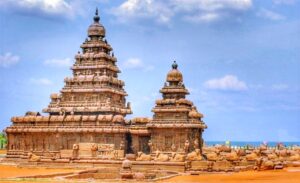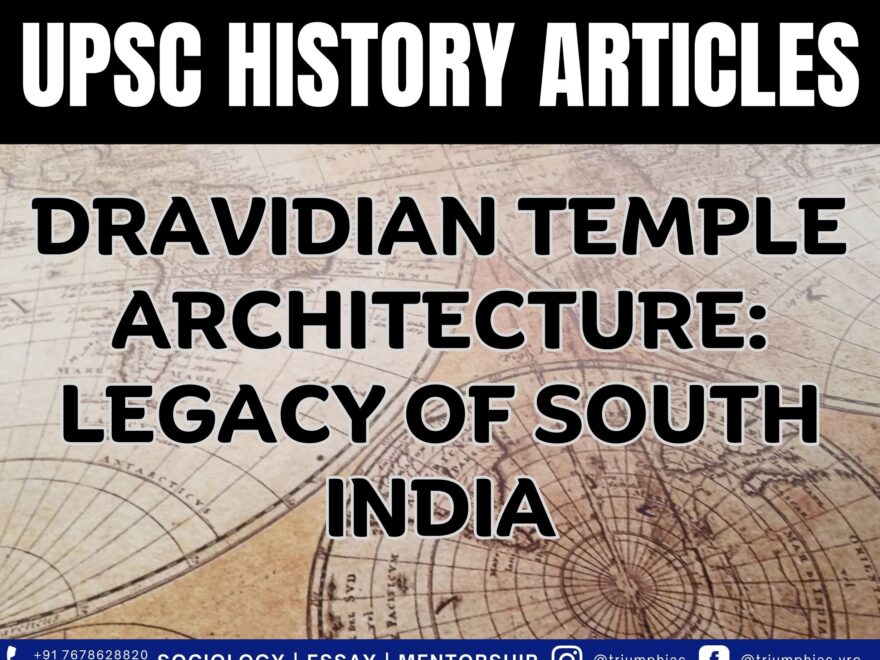Dravidian Temple Architecture
(Relevant for Historical section of General Studies Paper Prelims/Mains)

Dravida Temple
In contrast to the nagara temple style, the dravida temple style is enclosed within a compound wall. The frontal wall features a central entrance gateway, referred to as a gopuram. The primary temple tower, known as vimana in Tamil Nadu, takes the form of a stepped pyramid that ascends geometrically, differing from the curving shikhara characteristic of North India. It is a common practice to discover a spacious water reservoir or temple tank encompassed within the complex. Subsidiary shrines are either integrated into the primary temple tower or positioned as distinct and separate small shrines adjacent to the main temple.
Kanchipuram, Thanjavur (also known as Tanjore), Madurai, and Kumbakonam stand out as the most renowned temple towns in Tamil Nadu. During the 8th-12th centuries, these towns witnessed temples assuming a role that extended beyond religious matters alone. Temples evolved into affluent administrative centers, exercising control over extensive land areas. Much like there are various subcategories of the principal nagara temple styles, analogous subdivisions exist within the realm of dravida temples as well.
These shapes can be categorized into five distinct forms:
- Square, often referred to as “kuta” or “caturasra.”
- Rectangular, known as “shala” or “ayatasra.”
- Elliptical, labeled as “gaja-prishta” or “elephant-backed,” also named “vrittayata,” deriving from wagon-vaulted shapes of apsidal chaityas with a horse-shoe-shaped entrance facade, commonly referred to as “nasi.”
- Circular, termed “vritta.”
- Octagonal, denoted as “ashtasra.”
The Pallavas stood as one of the ancient South Indian dynasties. They extended their dominion to various regions of the subcontinent, occasionally stretching their influence to the boundaries of Odisha, and their ties with South-East Asia remained robust.
While predominantly followers of Shaivism, traces of Vaishnava shrines also persisted during their rule, and their connection to the extensive Buddhist history of the Deccan is evident. The prevalent belief is that their initial constructions were hewn from rock, while later ones adopted a structural approach.
These earlier edifices are generally attributed to the reign of Mahendravarman I, who lived concurrently with the Chalukyan king, Pulakesin II of Karnataka.
Narasimhavarman I, renowned as Mamalla, spearheaded most of the construction projects at Mahabalipuram, which eventually became known as Mamallapuram.
The shore temple at Mahabalipuram was constructed later, likely during the rule of Narasimhavarman II, also known as Rajasimha, reigning from 700 to 728 CE.
The temple encompasses three shrines, two dedicated to Shiva, facing east and west, and a central one devoted to Vishnu.
Within the complex, remnants of a water tank and an early version of a gopuram (ornate entrance tower) can be observed, along with numerous other sculptures.
Carvings of the bull, Nandi, the mount of Shiva, adorn the temple walls. These, along with the engravings on the temple’s lower walls, have suffered significant erosion due to exposure to salt-laden air over centuries.
The splendid Shiva temple in Thanjavur, known as the Rajarajeswara or Brahadeeshwarar temple, was finalized around 1009 under the patronage of Rajaraja Chola. This temple stands as the most expansive and tallest among all Indian temples. Within this temple, one can observe a remarkable feature – two sizable gopurams (entrance towers) adorned with intricate sculptures. This elaborate sculptural program was envisioned in conjunction with the temple’s design.
To master these intricacies and fare well in the Sociology Optional Syllabus, aspiring sociologists might benefit from guidance by the Best Sociology Optional Teacher and participation in the Best Sociology Optional Coaching. These avenues provide comprehensive assistance, ensuring a solid understanding of sociology’s diverse methodologies and techniques.
Dravidian temple architecture, Dravida temple style, gopuram, vimana, temple tank, Kanchipuram, Thanjavur, Madurai, Kumbakonam, Pallavas, Cholas, temple towns, temple shapes, kuta, shala, gaja-prishta, vritta, ashtasra, rock-cut temples, structural temples, Mahendravarman I, Narasimhavarman I, Mamallapuram, Mahabalipuram, shore temple, Brahadeeshwarar temple, Rajarajeswara temple, Rajaraja Chola, Indian temples, South Indian architecture, Best Sociology Optional Coaching, Sociology Optional Syllabus.

Choose The Best Sociology Optional Teacher for IAS Preparation?
At the beginning of the journey for Civil Services Examination preparation, many students face a pivotal decision – selecting their optional subject. Questions such as “which optional subject is the best?” and “which optional subject is the most scoring?” frequently come to mind. Choosing the right optional subject, like choosing the best sociology optional teacher, is a subjective yet vital step that requires a thoughtful decision based on facts. A misstep in this crucial decision can indeed prove disastrous.
Ever since the exam pattern was revamped in 2013, the UPSC has eliminated the need for a second optional subject. Now, candidates have to choose only one optional subject for the UPSC Mains, which has two papers of 250 marks each. One of the compelling choices for many has been the sociology optional. However, it’s strongly advised to decide on your optional subject for mains well ahead of time to get sufficient time to complete the syllabus. After all, most students score similarly in General Studies Papers; it’s the score in the optional subject & essay that contributes significantly to the final selection.
“A sound strategy does not rely solely on the popular
Opinion of toppers or famous YouTubers cum teachers.”
It requires understanding one’s ability, interest, and the relevance of the subject, not just for the exam but also for life in general. Hence, when selecting the best sociology teacher, one must consider the usefulness of sociology optional coaching in General Studies, Essay, and Personality Test.
The choice of the optional subject should be based on objective criteria, such as the nature, scope, and size of the syllabus, uniformity and stability in the question pattern, relevance of the syllabic content in daily life in society, and the availability of study material and guidance. For example, choosing the best sociology optional coaching can ensure access to top-quality study materials and experienced teachers. Always remember, the approach of the UPSC optional subject differs from your academic studies of subjects. Therefore, before settling for sociology optional, you need to analyze the syllabus, previous years’ pattern, subject requirements (be it ideal, visionary, numerical, conceptual theoretical), and your comfort level with the subject.
This decision marks a critical point in your UPSC – CSE journey, potentially determining your success in a career in IAS/Civil Services. Therefore, it’s crucial to choose wisely, whether it’s the optional subject or the best sociology optional teacher. Always base your decision on accurate facts, and never let your emotional biases guide your choices. After all, the search for the best sociology optional coaching is about finding the perfect fit for your unique academic needs and aspirations.
To master these intricacies and fare well in the Sociology Optional Syllabus, aspiring sociologists might benefit from guidance by the Best Sociology Optional Teacher and participation in the Best Sociology Optional Coaching. These avenues provide comprehensive assistance, ensuring a solid understanding of sociology’s diverse methodologies and techniques. Sociology, Social theory, Best Sociology Optional Teacher, Best Sociology Optional Coaching, Sociology Optional Syllabus.
Best Sociology Optional Teacher, Sociology Syllabus, Sociology Optional, Sociology Optional Coaching, Best Sociology Optional Coaching, Best Sociology Teacher, Sociology Course, Sociology Teacher, Sociology Foundation, Sociology Foundation Course, Sociology Optional UPSC, Sociology for IAS,
Follow us :
🔎 https://www.instagram.com/triumphias
🔎https://www.youtube.com/c/TriumphIAS
https://t.me/VikashRanjanSociology
Find More Blogs
|
Scope of the subject and comparison with other social sciences |
|||
|
|
|
|
Modernity and social changes in Europe |

